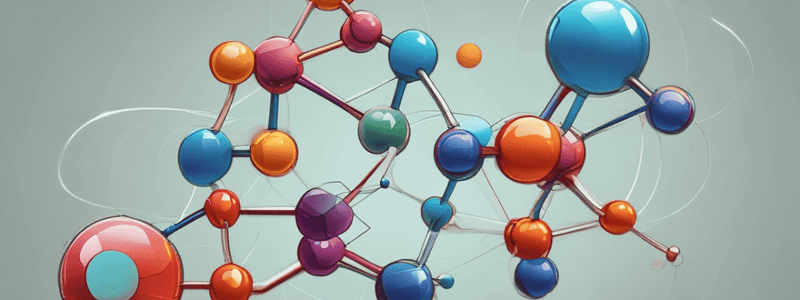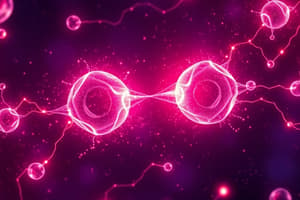Podcast
Questions and Answers
What is a characteristic of covalent substances?
What is a characteristic of covalent substances?
They have low melting and boiling points.
Why do most covalent substances not conduct electricity?
Why do most covalent substances not conduct electricity?
Because they do not break up to form ions.
What is electronegativity?
What is electronegativity?
The ability of an atom in a covalent bond to attract the shared pair of electrons.
How can electronegativity values be used?
How can electronegativity values be used?
What type of bond is formed when the difference in electronegativity values is greater than 1.7?
What type of bond is formed when the difference in electronegativity values is greater than 1.7?
What is the purpose of recrystallization in the experiment?
What is the purpose of recrystallization in the experiment?
Why must all equipment be kept hot during the experiment?
Why must all equipment be kept hot during the experiment?
What happens to the soluble impurities during the experiment?
What happens to the soluble impurities during the experiment?
Why is the melting point of the recrystallized benzoic acid measured?
Why is the melting point of the recrystallized benzoic acid measured?
What would be the effect of impurities on the melting point of benzoic acid?
What would be the effect of impurities on the melting point of benzoic acid?
Flashcards are hidden until you start studying
Study Notes
Chemical Bonding
- Chemical bonding occurs when 2 or more elements combine in a chemical reaction, forming a compound.
- A compound is a substance made up of two or more different elements chemically combined.
- Examples of chemical formulas: H₂O, SO₂, HCl
Water of Crystallisation
- Hydrated substances contain molecules of water in definite proportions.
- Water bound in this way is called water of crystallisation.
- Heating removes this water, and compounds without this water attached are called anhydrous.
The Octet Rule
- Noble gases are extremely stable due to their electronic configuration, which includes 8 electrons in their outer energy level.
- The Octet Rule states that when bonding occurs, atoms tend to reach an electronic arrangement with 8 electrons in their outermost energy level.
- Exceptions to the Octet Rule:
- Elements close to He tend to lose electrons to have 2 electrons in their outermost energy level.
- Transition elements (d-block metals) do not obey the Octet Rule.
- The rule sometimes works for sulphur and phosphorous, but not always.
Valency
- The valency of an element is the number of bonds an atom of the element forms when it reacts.
- Valency can be found by identifying the number of electrons an atom must lose, gain, or share to get a stable electronic configuration (i.e. Nobel Gas configuration).
- Examples of valency:
- Sodium (Na): 1 bond
- Oxygen (O): 2 bonds
- Carbon (C): 4 bonds
Ionic and Covalent Bonding
- Ionic bonds are created by the transfer of electrons.
- Ionic bonds are formed between the electrostatic attraction (unlike charges attract) between the cation and anion.
- Examples of ionic bonds:
- Lithium fluoride (LiF)
- Calcium and flourine
- Covalent bonds involve the sharing of electrons.
- Covalent bonds are formed when two non-metal atoms share a pair of electrons.
- Examples of covalent bonds:
- Hydrogen (H₂)
- Hydrogen chloride (HCl)
Crystalline Structure of Ionic Compounds
- Ionic bonding does not create individual small molecules.
- Instead, crystal structures in the shape of a lattice are formed.
- The anions and cations attract each other and form a rigid 3-D shape.
Characteristics of Ionic Compounds
- High melting and boiling points.
- Solids at room temperature.
- Dissolve in water.
- Conduct electricity.
- Examples of ionic compounds:
- Sodium chloride (NaCl)
- Calcium carbonate (CaCO₃)
Covalent Bonding
- Covalent bonds can be formed between:
- Atoms of the same element (e.g. H₂)
- Atoms of different elements (e.g. HCl)
- Electrons in a covalent bond:
- Bond pairs (shared electrons)
- Lone pairs (unshared electrons)
- Examples of covalent bonds:
- Water (H₂O)
- Ammonia (NH₃)
Sigma and Pi Bonding
- Sigma (σ) bonds:
- Formed by the end-on overlap of orbitals.
- Single pair of electrons shared.
- Pi (π) bonds:
- Formed by the sideways overlap of p-orbitals.
- Multiple pairs of electrons shared.
- Examples of sigma and pi bonds:
- Oxygen (O₂): 1 σ bond, 1 π bond
- Nitrogen (N₂): 1 σ bond, 2 π bonds
Polar and Non-Polar Covalent Bonding
- Non-polar bonds:
- Electrons shared equally between atoms.
- Example: Hydrogen (H₂)
- Polar bonds:
- Electrons shared unequally between atoms.
- Example: Hydrogen chloride (HCl)
- Electronegativity:
- The ability of an atom in a covalent bond to attract the shared electrons.
- Examples of electronegativity values:
- Hydrogen (H): 2.20
- Chlorine (Cl): 3.16
Predicting Bonds
- Electronegativity values can be used to predict what types of bonds will be formed between atoms.
- The greater the difference in electronegativity values, the greater the degree of polarity.
- Examples of predicting bonds:
- CS₂: non-polar covalent bond
- HBr: polar covalent bond
- NaCl: ionic bond
Studying That Suits You
Use AI to generate personalized quizzes and flashcards to suit your learning preferences.




